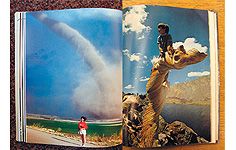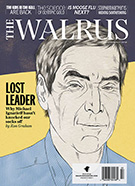Books discussed in this essay:
Travels with Herodotus
by Ryszard Kapuscinski
Knopf (2007), 275 pp.
Mali Blues
by Lieve Joris
Lonely Planet (1998), 291 pp.
The Rebels’ Hour
by Lieve Joris
Grove Press (2008), 299 pp.
But two recent books demonstrate, perhaps, that what we carelessly refer to as “travel literature” is, at this moment, a pirogue trapped in a cul-de-sac of a mangrove swamp on an African river — waterways the Victorian writer Mary Kingsley described in her Travels in West Africa as “utter frauds which will ground you within half an hour of your entering them.” Kingsley’s point about the devious complexity of African rivers is that one enters an open, inviting channel with complete confidence and a sure sense of direction, only to find oneself in a dead end, disoriented and confused. Travel literature, a genre all about journeys, has lost its way in the post-colonial era.
Floundering and aimlessness should not surprise us. Travel literature, at least since the travels and writings of Herodotus in the fifth century BC, has always reflected the enthusiasms, optimisms, passions, and predilections of the period in which it was written. Could Mary Wortley Montagu have written her Turkish letters any earlier than the eighteenth century? Could Sir Richard Burton have gotten away with his hubristic disguise as a Pashtun believer (prudently circumcised) sneaking into Medina any later than the 1850s? Could Bruce Chatwin have beguiled us so with Songlines at any other time than the late 1980s? What we now read as classic travel literature is in fact the documentation of very particular periods of colonialism and empire building, the records of well-funded, well-educated aristocrats and grandees, charging up and down the rivers of Africa, across the Arctic, and down to Antarctica, looking for cities (Timbuktu), routes (the Northwest Passage), and sources (the Niger and the Nile), as well as particular botanical specimens. Travel literature was about mapping and charting the unknown; explorers saw everything as virgin territory, to be baptized with the names of sponsors and loved ones. Not coincidentally, while writing beautifully they were also laying the ground for commercial exploitation and political dominance.
Since the 1960s, the explosive politics of Asia and Africa and revolutions in Eastern Europe have nurtured a rich tradition of literary reportage (highbrow, expository travel literature) by the likes of Robert Kaplan, Ryszard Kapuscinski, and Isabel Hilton. And the dilettantish renaissance in the 1980s — the obsessively romantic and man-alone exploits of such writers as Theroux, Chatwin, and Jonathan Raban, and the success of publications like Granta — reflected a fin de siècle exuberance that was blown out like a candle in September 2001.
The heroic is no longer compelling. There are few places under the sun that cannot be found with the help of global positioning technology (which is how the source of the Amazon was finally confirmed in 2000). Almost anyone can get to the top of a remote glacier and send a photo home via satellite phone. Travel, and travel literature, used to be about being the first person to do or see something; it is increasingly about being the last to chronicle a shrinking wilderness or witness a creature facing extinction. And in a world in which exodus and exile are the journeys that matter — Zimbabweans swimming across the Limpopo to South Africa, Somalis fleeing to Yemen, Burmese refugee camps in the borderlands of Thailand — the great white perspective on the exotic seems irrelevant, even insulting.
And this malaise is deepened by the great debate, still, among writers and critics, about the use of fiction and its techniques in the writing of what purists insist must be a literal, linear truth: no combining of journeys into a single compelling narrative, no turning of real people into composite characters, no dialogue that is not diligently transcribed and therefore checkable, no excision of the boring and the mundane, and certainly no flights of magic realism. But despite its banner-flying history as fearless exploration, travel writing has always been rooted in the outside culture’s self-regard and imagination, has always had more than a whiff of fantasy about it, which is why the best travel literature is often written by novelists and poets, whose very craft is about making something greater and more thrilling than its parts.
Two books exemplifying the pirogue becalmed in the mangroves are by two great recent practitioners of the form: the Polish writer Ryszard Kapuscinski, who died in 2007, and the Belgian writer Lieve Joris.
Travels with Herodotus is the most recent Kapuscinski book translated into English, and it is more of a memoir and a meditation than a piece of travel literature. After the compelling opening chapters, describing the author’s transformation from a naive and incoherent young reporter (wearing a yellow nylon shirt and “massive loafers”) into a foreign correspondent in India and China, the book is largely a meandering engagement with the writings of Herodotus, the Greek “father of history” — Kapuscinski would call him a writer of investigations — whose book The Histories was a gift to Kapuscinski from his first editor.
Kapuscinski is concerned with the “why” of reportage, for which he takes Herodotus as a model, his teacher: “To prevent the traces of human events from being erased by time,” because Herodotus was “obsessed with memory . . . it is what elevates man above beasts.” He teases out Herodotus’s fascination with war in a world that was “a bright Arcadia which every few years overflows with blood.” Only the frequency (and the size of the world) has changed; Kapuscinski famously claimed to have covered more than twenty-seven coups and revolutions as a reporter, in close to twenty-five books, fewer than half of which have been translated into English.
















Comments (2 comments)
Travel Guides: These were great recommendations, I'm looking to purchase 'Travels with Herodotus' soon.
Best July 22, 2008 13:01 EST
Anonymous: With respect to Ed Hardy, there is a need for us to say something about its celebrated designersOne is Don Ed Hardy, who is known as the god father in the contemporary tattoo world of the United States.Another is Christian Audigier, often referred as "king of jeans", was once the designer of some famous brands, such as Diesel, Levi's, etc.ed hardy uk.There is no gainsaying that the cooperation of the two people has aroused bright sparks coach handbags, giving a new climate surrounding fashion world.However, as far as I am concerned, their designs also have some negative effects that shouldn’t be ignored. Specifically, they can be concluded as follows:ed hardy shoes , rolex watches
December 31, 2009 00:46 EST